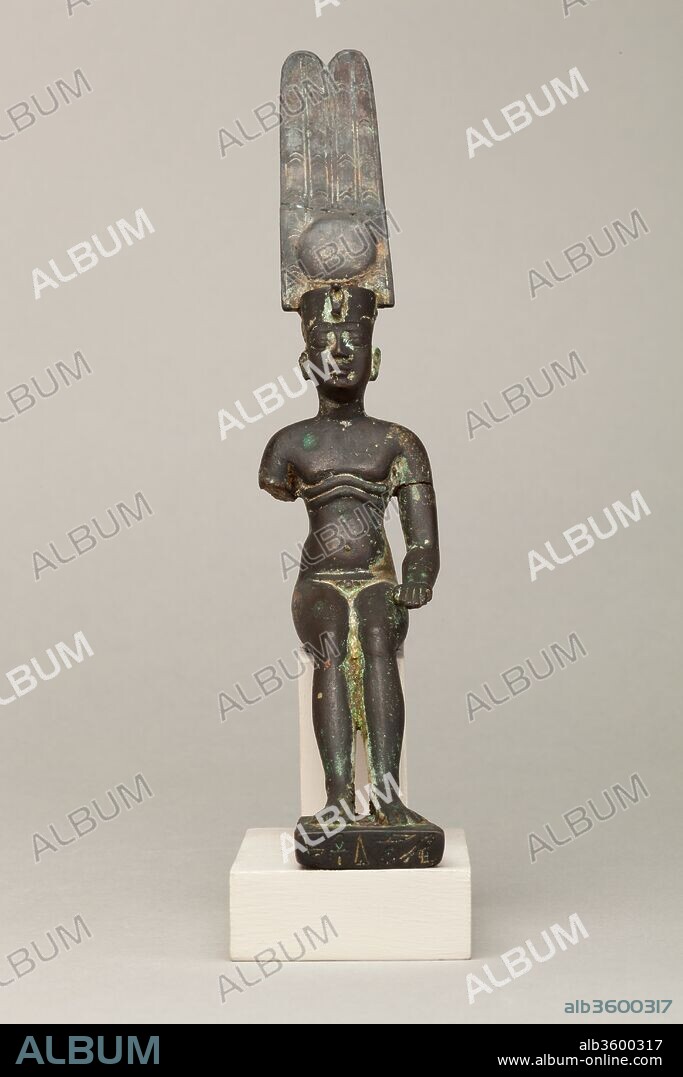alb3600317
Child god wearing Amonian crown and named Horus of Mednit (Aphroditopolis)

|
Añadir a otro lightbox |
|
Añadir a otro lightbox |



¿Ya tienes cuenta? Iniciar sesión
¿No tienes cuenta? Regístrate
Compra esta imagen.
Selecciona el uso:

Título:
Child god wearing Amonian crown and named Horus of Mednit (Aphroditopolis)
Descripción:
Traducción automática: Niño dios con corona amoniaca y llamado Horus de Mednit (Afroditopolis). Dimensiones: H. 18,3 cm (7 3/16 pulg.); W. 4 cm (1 9/16 pulg.); D. 11,1 cm (4 3/8 pulg.). Fecha: 664-30 A.C. La figura representa a un dios niño en posición sedente/reclinada, ataviado con la corona de doble pluma, que lo asocia con el dios Amón. El dios niño generalmente se distingue de los dioses adultos por una variedad de pistas iconográficas: su desnudez, el dedo levantado hacia la boca (un gesto infantil) y un mechón lateral en el lado derecho de su cabeza. El brazo derecho de esta figura está roto y, por lo tanto, se desconoce la posición de la mano; probablemente lo sostuvo en su boca o en su costado, como el brazo izquierdo. La cerradura lateral tampoco está en evidencia, pero su desnudez es suficiente para identificarlo como un niño dios. Debajo de sus pectorales, el niño dios tiene dos rollos gordos estilizados, una característica que es muy poco común en este tipo de estatuillas. Sin embargo, muchos niños dioses se muestran con vientres redondeados o regordetes, mostrando la capacidad del dios para generar prosperidad y abundancia; estos rollitos gordos expresan las mismas ideas. Los niños dioses crecieron en popularidad y culto desde el Tercer Período Intermedio en adelante, rivalizando incluso con los dioses más poderosos y antiguos, especialmente como ofrendas en los templos. Debido a su profusión y muchas formas locales, generalmente es muy difícil asignar identidades precisas a los niños dioses, pero una inscripción en la base nombra a esta figura como Horus de Mednit.
Child god wearing Amonian crown and named Horus of Mednit (Aphroditopolis). Dimensions: H. 18.3 cm (7 3/16 in.); W. 4 cm (1 9/16 in.); D. 11.1 cm (4 3/8 in.). Date: 664-30 B.C..
The figure represents a child god in a seated/reclining position, wearing the double feather crown, which associates him with the god Amun. The child god is usually distinguished from adult gods by a range of iconographic clues: his nudity, the finger raised to the mouth (a child-like gesture), and a sidelock on the right side of his head. The right arm of this figure is broken, and thus the position of the hand is unknown; likely it was held at his mouth or at his side, like the left arm. The sidelock also is not in evidence, but his nudity suffices for identification as a child god. Below his pectorals, the child god has two stylized fat rolls, a feature that is very uncommon on these types of statuettes. Nevertheless, many child gods are shown with rounded or chubby bellies, showcasing the god's ability to bring about prosperity and abundance; these fat rolls express the same ideas.
Child gods grew in popularity and cult from the Third Intermediate Period onwards, rivaling even the most powerful and ancient gods, especially as temple offerings. Because of their profusion and many local forms, generally it is very difficult to assign precise identities to child gods, but an inscription on the base names this figure as Horus of Mednit.
Técnica/material:
Cupreous metal
Periodo:
Late Period-Ptolemaic Period
Museo:
Metropolitan Museum of Art, New York, USA
Crédito:
Album / Metropolitan Museum of Art, NY
Autorizaciones:
Modelo: No - Propiedad: No
¿Preguntas relacionadas con los derechos?
¿Preguntas relacionadas con los derechos?
Tamaño imagen:
2934 x 4400 px | 36.9 MB
Tamaño impresión:
24.8 x 37.3 cm | 9.8 x 14.7 in (300 dpi)
Palabras clave:
 Pinterest
Pinterest Twitter
Twitter Facebook
Facebook Copiar enlace
Copiar enlace Email
Email
